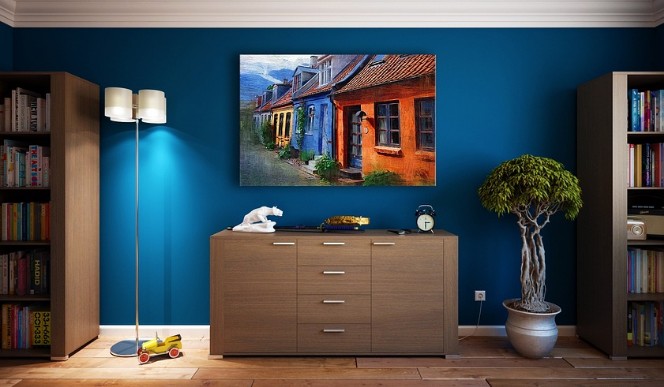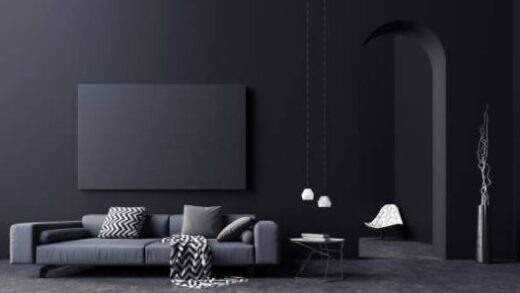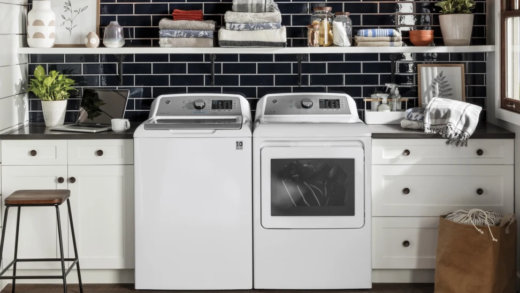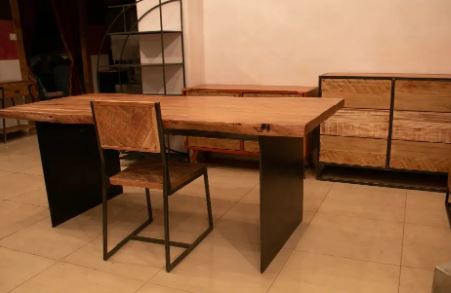Each of us has some furniture in our homes that could use some updating. There may not be enough money to visit a furniture restorer. Why not perform the task yourself as a DIYer? There are many clever ways to give furniture pieces in your house a fresh look and new life. Chalk painting is one common technique.
This instruction manual is for novice chalk painters. Everything you need to know about chalk painting furniture will be covered in this article.
Table of Contents
Prepping Your Workspace
The area where you will chalk paint your furniture piece is your workspace. Open all windows before you start, or use a fan to create airflow.
Before you start painting, make sure you have enough space to move around and that all of the necessary tools are close at hand. Also, clean and organize your workspace.
You will need to cover nearby walls, floors, or other objects if the item you are painting cannot be moved because it is too large or fixed in place (such as cabinets). Before painting, make any necessary repairs to the piece.
Tools Needed
Before you begin chalk painting, there are some tools you should have on hand:
- Chalk paint: There are several brands of chalk paint, which we will discuss later. For chalk paints, Annie Sloan is the most recognizable name.
- Paint can opener. Knives, bottle openers, and screwdrivers should not be used as alternatives because they may warp the can’s lid or opening. Due to this, when you finish your project and put the lid back on, leftover paint runs the risk of drying out or leaking from the can. Ask for a paint can opener; they are frequently provided free of charge with paint purchases.
- Paint stir stick(s). When you buy paint, you should always request that the store shake it for you. However, it’s always a good idea to thoroughly stir your paint before beginning if there will be more than a few days between the day you buy your paint and the day you actually use it. Wooden paint stir sticks are frequently offered for free if you ask, just like paint can openers.
- Drop cloth: To cover your workspace, you require the drop cloth. It will assist you in avoiding painting the floor or the area you’re working in. A drop cloth doesn’t require cleaning before use.
- Degreaser or cleaner: The surface will be cleaned of dirt, grease, oils, dust, and spills using the degreaser or cleaner. You can apply a coat of chalk paint that looks its best if you take the time to thoroughly clean your item.
- Screwdriver: You might discover that you don’t want to paint the furniture’s decorative elements, functional attachments, or hardware. To remove any objects you don’t want painted, use a screwdriver. The subsequent application of chalk paint may be harmed by cleaning the paint from them..
- Protective gear: All paints contain some level of toxicity. When inhaled for extended periods of time, even chalk paints can make one feel lightheaded. To prevent breathing in the fumes while working, you can wear a face mask. Even better would be to work in a well-ventilated environment. Wearing clothes you don’t mind getting dirty may be the best option, but you can protect your clothes with an apron. Wearing gloves will prevent paint and any primer you may use from getting on your hands and nails.
- Painter’s tape: When you want to cover some areas of your project that you do not want to paint, painter’s tape comes in handy. It can also be used to create recognizable patterns, like stripes in various colors. Painter’s tape can be used to cover furniture hardware that is difficult to remove. The different widths of painter’s tape are available for use in a variety of situations.
- Brushes: Regular paint brushes work just as well as brushes made specifically for chalk paint. With chalk paint, you don’t have to be perfect; in fact, brush strokes work better for projects with a rustic or farmhouse aesthetic. Use a self-leveling chalk paint to cover brush strokes or lightly sand the final coat of paint before sealing it if you don’t want them to show through your finished project.
- Wax or Poly Sealant: A sealing solution offers the paint an additional layer of defense against grime, moisture, spills, and wear. Additionally, it adds sheen and frequently results in a richer paint color.
What Is Chalk Paint, Also Known As Chalk-style Paint?
The first brand of paint I ever used in a chalk-style was chalk paint, which was initially developed by Annie Sloan. (and I have, however, diversified and now regularly use a number of others in addition to the one I still use and adore.
- Annie describes her Annie Sloan Chalk Paint as having “a velvety, ultra matte finish” and it is a “versatile paint that would work beautifully on furniture without priming or sanding; that would be easy to use and quick to dry, and that could be used for a number of different paint techniques.”
- Dixie Belle, another favorite of mine, is described as “High-quality mineral chalk paint is perfect for painting on furniture and can be used on wood, metal, glass, ceramic, fabric and more.”
- Another favorite is by Rustoleum, “Rust-Oleum Chalked Ultra Matte Paint, offers a velvety smooth, vintage look” and “creates an ultra-matte finish with superior adhesion and coverage.”
How To Chalk Paint Furniture
Choose The Object That Needs A Makeover In Step 1.
I always advise practicing on a smaller piece when learning how to chalk paint before applying it to a larger piece. There is a small learning curve with chalk-style paint if you are used to using latex or acrylic types of paints. Before using a product on something significant or substantial, it is always a good idea to get a feel for its properties.
Next, pick the item you want to transform.
Step 2: Compile All Of Your Project-related Materials.
It’s a good idea to gather everything in advance so you are ready for anything that may occur while painting.
The great thing about chalk paint is that, if there is space, painting can be done inside the house with virtually no fumes at all.
When necessary, I like having a painting studio at home. This is definitely a “win” for chalk paint in the whole painting furniture category.
A foam roller (like those for cabinets, etc.) is another option. I mainly use a brush, though occasionally I’ll use a foam roller as well.
The only exception is when I’m painting very large items or kitchen or bathroom cabinets. In these circumstances, the roller will be your ally.
TIP: I will first use a brush to evenly apply the paint all over, in the crevices, etc., on cabinet doors with large flat areas, sides, and areas with raised trim. After that, use a cabinet roller to smooth out the entire area once more.
Step 3: Prepare And Clean Your Piece.
It’s crucial to thoroughly clean your furniture piece. In order for your paint to adhere properly, you don’t want any dirt or grime to show through.
Depending on how much cleaning you need to do, you can use denatured alcohol, TSP, all-purpose cleaner, Windex, soap and water, or all of the above.
After cleaning it, you must prepare the area. Not every piece will require the same level of preparation as another.
Sand the surface smooth after using wood filler to repair any holes, gaps, chips, etc.
You will need to sand any additional rough spots to make them smoother.
I know everyone says chalk paint is “no-prep” but that’s not entirely true. You may occasionally need to sand something.
You should sand a surface a little to take some of the shine off, for instance, if it is extremely shiny (like the laminate below). (or you will not be so happy with the outcome)
Now, when I say “sanding,” I don’t mean completely scraping off the finish. I’m only referring to slightly removing the shine OR to even out an uneven finish.

4. Begin Painting.
To remove any debris that may have adhered to the brush, soak it in water before you start painting. Also wet the brush. Utilize a paper towel to dry off the extra water.
In order to achieve the desired consistency, stir the paint and, if it seems too thick, add a little water.
Put down the first coat of paint to start painting. Just a little chalk paint goes a long way, and we can’t emphasize that enough! Since this paint is thinner than regular paint, you won’t need to load your brush with nearly as much paint. First, until you understand how chalk paint spreads when applied with a brush, be cautious when dipping your brush.
Depending on the surface, one coat may be sufficient while two may be necessary. Rarely will you require a third coat.
Lightly sand between coats to achieve a smooth finish. Before applying the next coat, give the paint some time to dry (at least an hour is recommended).
5. Add Graphics, Transfers, Or Stencils.
The time has come to add transfers, stencils, or graphics. (lettering, etc.)
Step 6. Finish Coat
At this point, I have used both and everything in between. Although I have my favorites, they might not be yours.
Let’s discuss these two now. Clear wax, dark wax, matte poly, gloss poly, etc. are some examples of wax and poly., and so many choices!
Let me start by saying that I hardly ever use poly that is oil-based. Additionally, these days I hardly ever use wax.
However, I am aware that some people are die-hard wax enthusiasts. Of course, it has advantages. However, just like poly, it has its disadvantages.
A soft material, such as a t-shirt, or a wax brush can be used to apply wax. (I have used wax brushes but my favorite way has always been old t-shirts)
Following application, wax requires buffing (I usually wait a few hours). For this, you can also make use of a wax brush or material from a fresh t-shirt. Although I have used a wax brush, I also enjoy using t-shirt material for this component.
Some Of The Best Chalk Paint Brands
Here are just a few favorite chalk-style paints:
- Annie Sloan Chalk Paint: A favorite of most DIYers, made by the original creator of chalk paint. The paint is thick and also calls for a topcoat. With water, you can thin it.
- Cece Caldwells: It is a natural and non-toxic chalk paint. Additionally, the brand uses stunning color schemes.
- Rustoleum Chalked Ultra-Matte Paint: In addition to needing some topcoats, it has a mild odor.
FAQs
How Long-lasting Is Chalk Paint?
When properly sealed and kept off of surfaces exposed to extreme heat or moisture, chalk paint can withstand the majority of typical household wear and tear. It can be used on outdoor furniture or decorative items, but to protect against the elements and UV rays, the paint will need exterior grade poly sealant products.
Painting indoor items is the best application for chalk paint. It is not advised for painting projects on the exterior of houses or other external structures, nor is it advised for painting interior rooms (ceilings, walls, floors), as the final coat must be sealed. You should use paints created especially for those purposes.
Is Chalk Paint Sturdy By Itself?
No, some people prefer to leave projects that they have chalk painted unfinished in order to achieve the best chalky finish. Use wax or poly sealer instead of this if you want to protect most chalk painting or decorative items that won’t be handled. This will improve cleaning and increase the longevity of your chalk paint job.
Conclusion
Once you master it, chalk painting can be a great way to give some items in your home a fresh coat of paint. We hope you find a new hobby with the help of this tutorial on how to chalk paint furniture.



